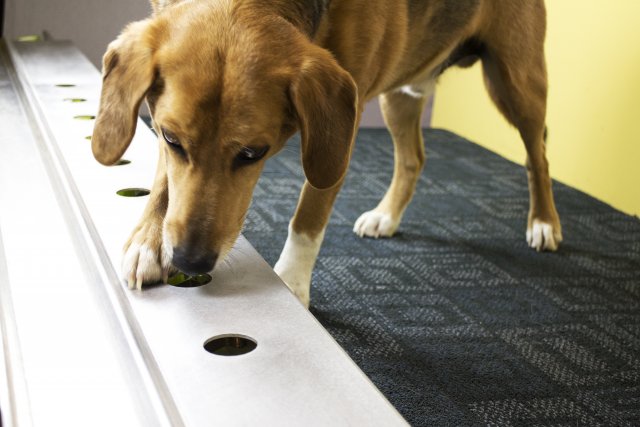Dogs May Teach Us How to Detect Cancer Earlier: EPA Scientists Explore Exhaled Breath Aerosol Samples to get Clues for Pre-Clinical Cancer Screening
Published December 10, 2019

Researchers in Canada have demonstrated1 that dogs can be taught to “sniff-out” cancer using human exhaled breath aerosol samples. While the dogs can’t tell us which chemicals they are detecting, they can be trained to reliably sort biological samples into cancer and not-cancer groups. How do the dogs do it? What chemicals are they detecting with their noses that lead them to sniff out cancer, and can we detect those chemicals in the lab? Ultimately, we might learn from the dogs which environmental chemicals and their metabolites are related to human health effects.
In a recent article published in the Journal of Breath Research , EPA investigators analyzed a series of samples collected from standard hospital masks that had been previously sorted into the cancer and non-cancer groups by trained dogs. The researchers used gas and liquid chromatography – mass spectrometry (GC- MS and LC-MS), and immunochemistry instrumentation to measure as many chemical compounds as possible in each sample, and then compared the cancer and non-cancer groups to see which chemicals were different.
In this study, EPA found that in the LC-MS analyses, there were distinct differences between mask samples sorted by the dogs, but not as much differentiation in the GC-MS analyses. From this, EPA researchers hypothesized that the dogs were detecting the aerosols (i.e., the tiny liquid droplets) part of breath to make their decisions, rather than the lighter gas-phase molecules (i.e., the gaseous part of breath).
This work needs further research to confirm the conclusion compounds and to achieve better statistical relevance. However, these results indicate that standard hospital masks can be used as a sampling medium for exhaled aerosols, and that LC-MS analyses can find compounds to separate groups similarly to the discrimination practiced by the dogs. This suggests that we may eventually be able to identify cancer at earlier stages.
1 See Rappaport and Smith, Environment and Disease Risk, Science Vol 330, Issue 6003, 460-461.
